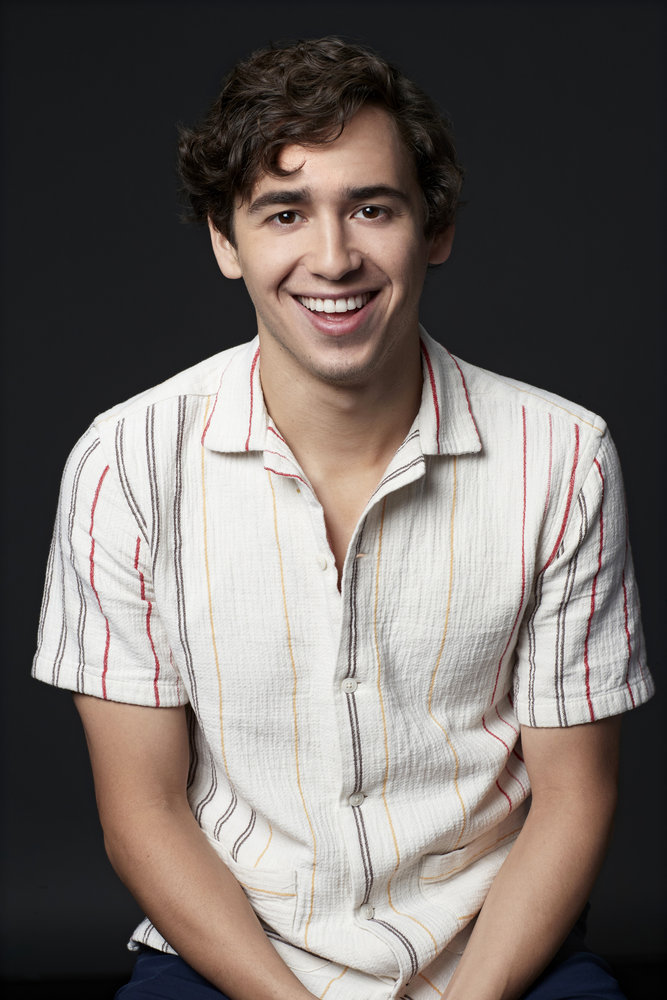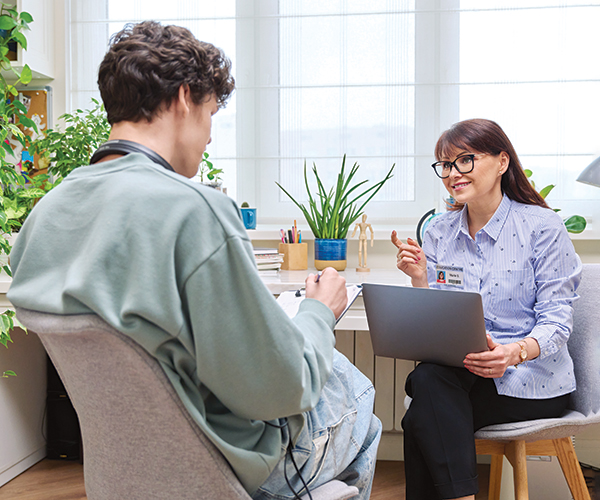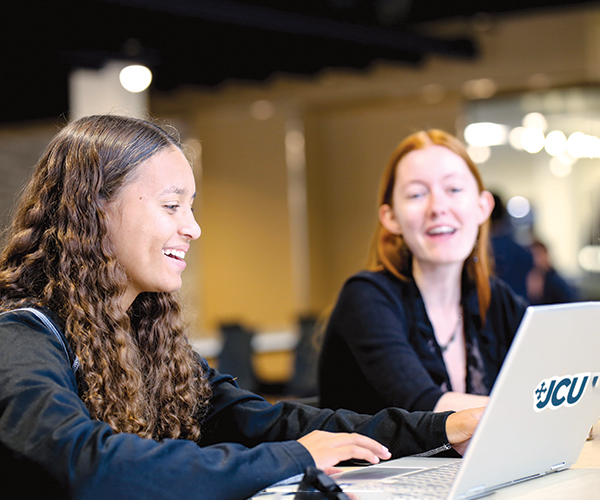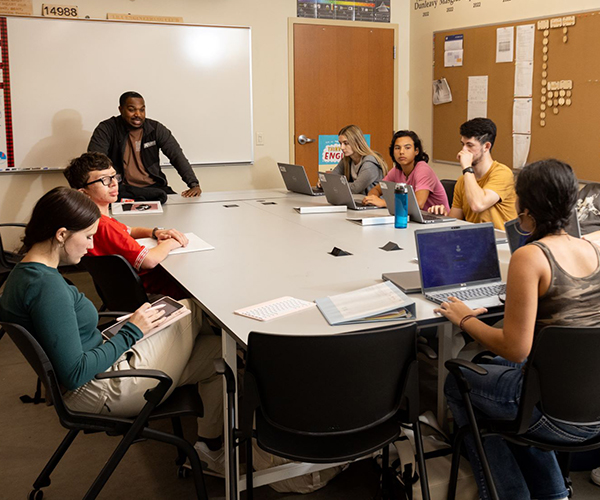How Music Helps Cleveland's Students Tune Into Education
by Kristen Hampshire | Feb. 27, 2024 | 12:00 PM

Courtesy Cleveland Metropolitan School District, Courtesy Lake Ridge Academy
Raahil Shammin has discovered a lot about who he is through music and several things he didn’t really expect. For one, he’s a math brain but unlocked a creative-emotional side that opened up a level of expression he credits to playing viola and performance.
“Arts in school allow you to really put yourself into academics,” explains the 18-year-old senior at North Ridgeville’s Lake Ridge Academy. He started taking cello lessons for a couple of years before switching to the versatile viola.
“It’s not just me writing down equations or facts,” he says. “The music I’m creating is part of myself that I’m showing the world.”
Shammin thanks his sharp presentation and communication skills for music education. The same goes for humble losses, accepting critique, and graciously receiving compliments.
“I’m way more comfortable in front of people because of playing in front of audiences,” he says. “And I have a lot of friends through music because it’s a collaborative thing, especially in orchestras with all the different sections of instruments communicating with each other.”
Beyond school-based performance groups, Shammin also plays in the Cleveland Orchestra Youth Orchestra and Northern Ohio Youth Orchestra. Winning a seat in these top-shelf groups requires auditions. That calls for practicing, polishing, commitment, time management and, of course, the goal-setting aspect of deciding you’re going to go for it.
Music promotes personal, academic, social and emotional growth.
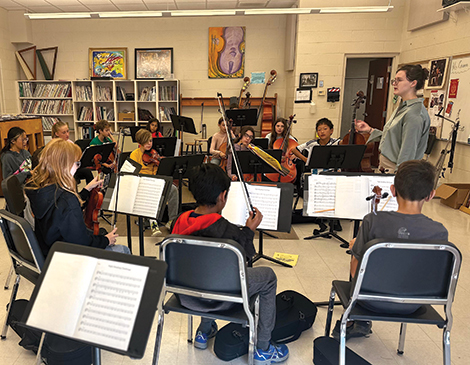
“There is a lot of research related to music and student success — and I see it in front of me,” says Mark Mauldin, director of bands at Solon High School, which is consistently recognized as a Best Communities for Music Education by the National Association of Music Merchants Foundation, acknowledging districts that provide music access and education to all students.
Mauldin says students in music “build confidence and have the ability to function in a wide range of social situations.” Plus, learning the language of music—a universal way of communicating — establishes connections socially and academically.
“The idea of note reading and rhythm reading activates a part of the brain that might not otherwise be activated,” he says.
The numbers prove it.
A study conducted by the University of British Columbia including 100,000 students showed those who participate in school music outperform those who don’t in math,
science and language arts. Findings also uncovered — not for the first time — that music education benefits traverse gender, ethnicity and socio-
economic status. By high school, those with multiple years of instrumental music class were one year ahead of their peers.
And you don’t have to play to win. You can listen, too.
According to a OnePoll market research study on behalf of Colorado State University Global that surveyed 2,000 Americans about music and their study habits. Those who turned on tunes showed it on report cards with higher GPAs.
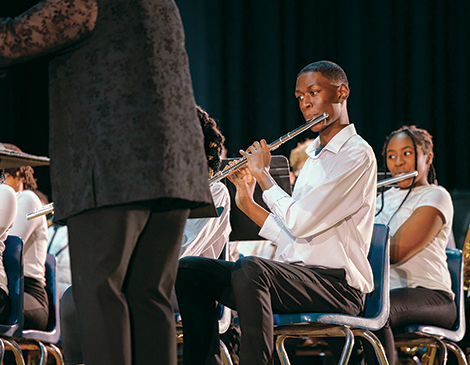
Music is universal. It’s the founding mission of The Music Settlement, established in 1912 for transitioning immigrants as a community common ground. “There are no language barriers that prevent people from sitting together to play their instruments,” points out Matthew Charboneau, chair for the Center for Music.
Artistically Fit to Grow
Right brain, left brain. Music engages the whole brain.
“When music is being played, performed and listened to, it fires off both sides of the brain,” Mauldin says.
Take Shammin. Music has redesigned his otherwise analytical mind.
“I’m naturally a mathematical thinker,” says Shammin, who expects to major in math when he goes away to college next year. At the same time, he’s submitting arts portfolios and plans to continue studying music theory and composition. “I want them to see that I’m just as much of an artist as I am a mathematician.”
He adds, “The balance between logic and emotion and combining those two worldviews can create a really well-balanced way of thinking, and it’s refreshing to rely on logic and emotion and not be ‘too brain’ or ‘too heart.’”
Ruth Cavano is Lake Ridge Academy’s orchestra teacher, and she likes to musically warm up the group with some stretching exercises. “There is a big overlap between music and sports,” she says, introducing yet another yin-yang that might be overlooked. Consider the bow hold, the movement, posture, intentional breathing. Add in teamwork, leadership and practice.
“Thinking of music as a sport can really illuminate what goes on in our classroom,” Cavano says. “Having that awareness of their own body with their instruments gives students confidence and helps them think about how their body works.”
Social awareness also sharpens when learning an instrument and with exposure to music. It’s a
common ground. Cavano dials back to her middle school days, noting how playing string bass carved a niche of belonging for her during what are typically awkward years for most students.
“I could go to the music room and practice,” she says. “It helped my confidence, and I had an awesome teacher who pushed me forward.”
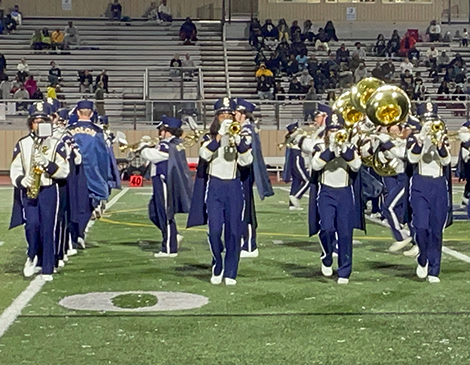
Music is community. It connects students, families and neighbors across generations. It’s a place to come together.
In Solon, the first “unofficial” performance of the school year is when the high school marching band arrives back from band camp and performs a show in the stadium.
“District families, alumni parents and other community members often purchase reserved seats for football games more to see the half-time shows than the actual athletic competition,” says Tamara Strom, administrator at the Solon Board of Education.
As for spilling into academics, beyond performance groups and classes, music at Solon High School includes academic offerings like AP Music Theory and a new offering for next year, World Music. It’s all part of developing the whole child, Mauldin and Strom say.
Skills, Skills, Skills
Music rounds out and enhances education. Mauldin says, “After more than 30 years in music education, I see how students are more well-rounded, confident, work better in groups and are great peer leaders.”
Results from a Gallup Survey, American Attitudes Toward Music, report that 95% of Americans believe that music is an activity a child can enjoy for a lifetime, and 96% say it’s a way for young people to develop teamwork skills. Not only does it instill an appreciation of arts and culture, music gives children a sense of accomplishment and 90% said it brings family together.
For our earliest learners, music note reading is much like learning the ABCs. Charboneau attributes instrumental music to enhanced cognitive functioning. Dalcroze Eurhythmics for the preschool set teaches children how to use the body as an instrument, moving to sounds and rhythms, building a foundation for instrumental music once age-appropriate. It stimulates motor function and teaches pattern and form.
“When you start strings as a young student,” Cavano adds, “learning an instrument helps build fine motor skills in ways that can be challenging to start off.”
In fact, a far-reaching menu of skills that benefit a whole life transfer from the musical experience.
Time Management:
Cramming last minute for a test generally doesn’t produce the results that consistent study habits deliver, and music teaches this time management and routine skill, too. Setting a goal, then working a little bit each day toward the “big picture” also fosters resiliency, a “keep on keepin’ on” mindset.
“In my professional experience, I see students start to take lessons and set up a schedule of practicing even just 15 minutes a day, and even that modest amount builds up over time,” Charboneau says, adding that he’s noticed the same success at home with musical and academic development.
Discipline gained from practice and performance builds skills like good, old-fashioned gumption.
“You have to persevere and stick with it during tough pieces or practice times to get to the next level,” Cavano points out. This feeds self-motivation and connects to resiliency — one skill sharpens another and flows beyond music into studies and life in general.
Shammin relates how auditions have prepared him for high-pressure situations. “Music has helped me get more practice with times when everything is dependent on that one moment,” he says.
Collaboration:
“Music is very social in a way I didn’t expect it to be,” Shammin says, noting how some of his closest friends are also music makers. “I’m working alongside people who really care about music and it’s such a bonding experience.”S
Self-Esteem:
Practicing for a performance and pulling it off successfully grows confidence. “I’ve seen positive self-esteem changes in my daughter during the past few years that I feel is attributable to music,” Charboneau says. “After participating in concerts and recitals, and interacting with other ensemble members, she has tackled challenges and really grown.”
Problem-Solving:
Just as inquiry-based learning in the classroom emphasizes there are many ways to solve a problem, music also underscores this skill. Music teaches a child: I can do hard things. Charboneau talks about how his daughter is instructed to break complex works of music into “practice pods.” Those sections a few measures long that she can digest and polish, eventually piecing together pods to play the complete piece. “It’s a successful way of tackling a bigger piece without getting intimidated,” he says. “You’re building muscle memory and familiarity.”
Accepting Feedback:
You don’t get better without doing your best — and owning the hard truth that someone else will always be better than your best. So you learn to lose, improve, excel and repeat.
“One of the things I emphasize especially around the time students are auditioning for seat placement or go to a competition, they feel they are ‘the best,’ and get beat because a judge didn’t feel the same way is the importance of losing gracefully,” Mauldin says.
He often shares his personal performance experiences. “I get to play in bands with musicians who are better than me, and I can learn from them,” he tells students. “If they beat me, ‘How did you beat me? Let me learn how to do that!’”
Across the board, failure can be more enlightening than success. Michael Jordan didn’t make his high school’s varsity basketball team one year. His mom told him to “get to the gym and work harder.” Before Thomas Edison got the lightbulb right, he failed 1,000 times. Didn’t stop him from trying.
“I try to help my students understand they are going to face a sense of rejection at some point, and music can be a way to help you through that, too — it’s an outlet,” Cavano says. “If you feel emotions in a big way, work through it with your instrument. Music is a safe space for expression.”
For more updates about Cleveland, sign up for our Cleveland Magazine Daily newsletter, delivered to your inbox six times a week.
Cleveland Magazine is also available in print, publishing 12 times a year with immersive features, helpful guides and beautiful photography and design.
Trending
-
1
-
2
-
3
-
4
-
5





